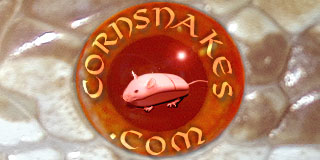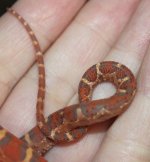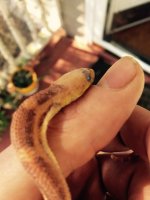Scaleless Everglades Rat Snakes
Hi Al!
Though, in my case, I am asking in relation to Everglades Rat Snakes, this would also apply to corn snakes carrying these genetics.
I recently stumbled across a happy find-- a baby scaleless Everglades rat snake at PetCo! I was visiting a friend who works at the local PetCo and when I arrived he excitedly told me that they had just gotten in a scaleless snake. He said that it was a first for this store and that he thought it was a scaleless texas rat snake.
Well, I saw her (she is female, I checked) and immediately had to have her! She is a PERFECTLY scaleless specimen, having only her belly scales and no scales anywhere else.
After doing a little research, I discovered that my friend was mistaken, she isn’t a texas rat, but an Everglades rat snake. SOOoo...I decided to search among the various classifieds for a male to match her with, but discovered that most scaleless snakes go for quite a bit more money than I paid for her (PetCo sold her to me for the same price as a regular texas rat snake--$125).
FINALLY, after a couple months of searching without finding any scaleless Everglades in my price range, I found a breeder who had some advertised for $160 and I called him to see if any of his were male. When he said, "Yes, I have a yearling male left", I said, "Sold".
However, once I received the male, I discovered that he isn’t NEARLY as ’scaleless’ as my female. In fact, he looks MUCH more like a ’micropave’ or ’microscale’ corn snake, than he does a scaleless rat snake. Only his head looks somewhat scaleless (just like the micropave or microscale corns), otherwise he DOES have scales all over his body, just really really small ones.
I guess the only way I can truly know for sure, is by waiting a couple of years and breeding the two of them, but I am anxious to hear from keepers more knowledge than my self regarding this mutation.
A few of the questions that have since occurred to me:
1) Could my male actually be het for scaleless and thus be showing partial expression of the scaleless gene?
2) Could my male actually be a micropave/microscale rather than scaleless?
3) Is there really so much variation in the expression of the scaleless gene that some carriers are just covered in really time scales, while others are completely scaleless?
If anyone has experience with this mutation, I would absolutely love to hear your thoughts on this. There is very little information out there regarding this morph and any help, advice, or opinions would be greatly appreciated!
Thanks In Advance!
Beau
Hi Al!
Though, in my case, I am asking in relation to Everglades Rat Snakes, this would also apply to corn snakes carrying these genetics.
I recently stumbled across a happy find-- a baby scaleless Everglades rat snake at PetCo! I was visiting a friend who works at the local PetCo and when I arrived he excitedly told me that they had just gotten in a scaleless snake. He said that it was a first for this store and that he thought it was a scaleless texas rat snake.
Well, I saw her (she is female, I checked) and immediately had to have her! She is a PERFECTLY scaleless specimen, having only her belly scales and no scales anywhere else.
After doing a little research, I discovered that my friend was mistaken, she isn’t a texas rat, but an Everglades rat snake. SOOoo...I decided to search among the various classifieds for a male to match her with, but discovered that most scaleless snakes go for quite a bit more money than I paid for her (PetCo sold her to me for the same price as a regular texas rat snake--$125).
FINALLY, after a couple months of searching without finding any scaleless Everglades in my price range, I found a breeder who had some advertised for $160 and I called him to see if any of his were male. When he said, "Yes, I have a yearling male left", I said, "Sold".
However, once I received the male, I discovered that he isn’t NEARLY as ’scaleless’ as my female. In fact, he looks MUCH more like a ’micropave’ or ’microscale’ corn snake, than he does a scaleless rat snake. Only his head looks somewhat scaleless (just like the micropave or microscale corns), otherwise he DOES have scales all over his body, just really really small ones.
I guess the only way I can truly know for sure, is by waiting a couple of years and breeding the two of them, but I am anxious to hear from keepers more knowledge than my self regarding this mutation.
A few of the questions that have since occurred to me:
1) Could my male actually be het for scaleless and thus be showing partial expression of the scaleless gene?
2) Could my male actually be a micropave/microscale rather than scaleless?
3) Is there really so much variation in the expression of the scaleless gene that some carriers are just covered in really time scales, while others are completely scaleless?
If anyone has experience with this mutation, I would absolutely love to hear your thoughts on this. There is very little information out there regarding this morph and any help, advice, or opinions would be greatly appreciated!
Thanks In Advance!
Beau



